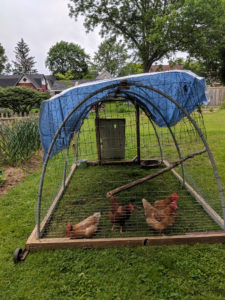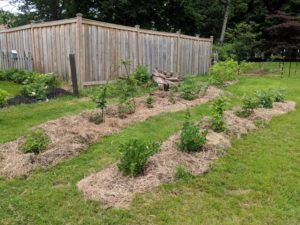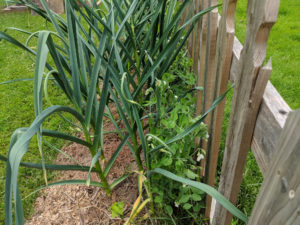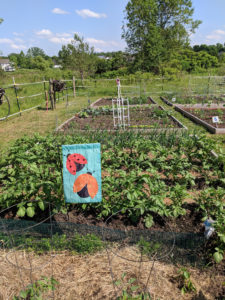Village Gardener: On lawns and edible landscapes
by Georgeanne Vyverberg –
This past Sunday I took part in an event at Ganandagan National Historic Site in Victor, NY. The presentation was given by Robin Wall Kimmerer, who is a

Photo Georgeanne Vyverberg
Distinguished Professor of Environmental studies at SUNY Environmental Science and Forestry in Syracuse, NY. I met Robin over 20 years ago as my teacher for a week-long seminar on Bryophytes, which is the study of mosses and liverworts. She is also a member of the Potawatomi Nation and the celebrated author of two books on plants where she weaves the Indigenous way of thinking and using plants into her views of the natural world of plant beings. Anyone interested in plants and indigenous uses of them with respect for each one’s uniqueness will want to read her books. One of Dr. Kimmerer’s remarks really got me thinking about our lawns. She noted that for every acre of lawn mowed we send out three tons of CO2 into the atmosphere. So, my half acre of “lawn” which has a lot of plantain and dandelions (which are useful as medicine and food) is creating half a ton each mowing! Just me! I try to walk softly on this earth but this fact startled me. I think it’s a lot less than half acre since I have created many gardens and planted several trees, but I am going to try harder. How? Well for one thing I have a small flock of hens and recently I purchased a “chicken tractor” which is simply a small hoop house that can be dragged around the lawn so that the chickens can graze on those grasses and weeds and hopefully any ticks, which are so problematic these days.

Also, I decided to dedicate a good size patch to edible fruits. So, this year I have planted Elderberries, red raspberries, thornless blackberries, gooseberries and currants in the spot that the neighborhood Mulberry used to inhabit. She sadly fell over during a bad storm last summer and is sorely missed by all the children, who used to climb it and sported red chins and clothing for a month in the summer. Trail cams caught on film a veritable safari of woodland animals. Also, the large flocks of birds including Crows, Blue jays, and Finches and Baltimore Orioles were drawn here, where we could sit in our yards with binoculars and watch their antics.
Its tempting to not mow at all but living in a small village community makes that hard to do as some people do not approve of carefree lawns. We can plant more trees and shrubs and edible plantings are surely the way to go. Besides mowing is hard work and takes valuable time and energy that can be expended in more fun activities like gardening.

Photo Georgeanne Vyverberg
Speaking of gardening..can you believe how fast summer came? Last time I wrote it was still so cold and then suddenly there was warmth and all the trees responded so quickly you could watch things unfold in fast motion. A friend of mine who works in an office building and has a tree outside her window watched it unfurl its buds into full blown leaves in the course of two days. There was something magical about it. Seeds planted in the warm earth are up in days. I have beans and peas flowering and my garlic has reached the point where it is putting up those scapes that are so beautiful but need to be pinched off when they start to lengthen. If you don’t the bulbs won’t get as big since energy will go to the flower instead. But don’t throw those scapes away since they can be used to make a pesto nearly as good as the bulbs. When years ago I was growing several hundred pounds of garlic, there were always some I missed and invariably the bulbs were smaller. However, the scapes become beautiful flowers and even with my small planting I like to leave one or two on purpose because I enjoy those flowers. If you let the flowers mature they will become tiny little bulbils which can be planted. I used to plant a small patch in my kitchen garden near the house and have fresh garlic chives in late spring.
Garlic scapes can be used in soups and stir fries and in exchange for garlic in your favorite pesto recipe. I also like to use it in humus.

I mentioned that I have taken a plot in the community garden here in Honeoye Falls a couple of months ago. Well I am loving it. Over 30 gardeners are taking advantage of this offering, but in fact I rarely find more than one or two gardeners there when I visit or work. It’s a very peaceful spot with birds serenading me (well I like to think so anyhow) as I work. I always take a walk around the plots and have found that there are 30 ways of doing things. No two plots look alike and there is so much creativity going on. Gardeners range in age from children to one gentleman of 86 who hauled compost from the pile provided by the town for himself and two others including myself. There are gardeners with lifetime experience and newbies making their very first garden. Everyone helping each other in person or on the community garden webpage. Several people who grew extra plants brought them to the garden to share and I took advantage of a single Broccoli plant and a couple of cucumbers as well as a few beautiful heirloom tomato plants. This is the garden’s third year and the history of the previous two years were hard learning experiences. The first one as a year of drought and the past year of flooding but this year the weather has been perfect going so far. Some who were there during those trying summers are taking measures to overcome any disasters. There is lots of bed building and many are using mulch. Well you know what I think of mulch. Its so wonderful how it protects the soil and builds it all at the same time.
Here are the titles by Robin Wall Kimmerer. She is also on a number of YouTube videos.
~ Gathering Moss, A Natural and Cultural History of Mosses
~ Braiding Sweetgrass, Indigenous Wisdom, Scientific Knowledge, and the Teaching of Plants
Georgeanne has been fascinated by plants ever since a neighbor gave her some flower seeds when she was very young. The magic of watching them sprout into beautiful flowers has become a lifetime of wonderment. She lives in Honeoye Falls with her canine and feline friends, small flock of chickens and more recently a rabbit, or two.